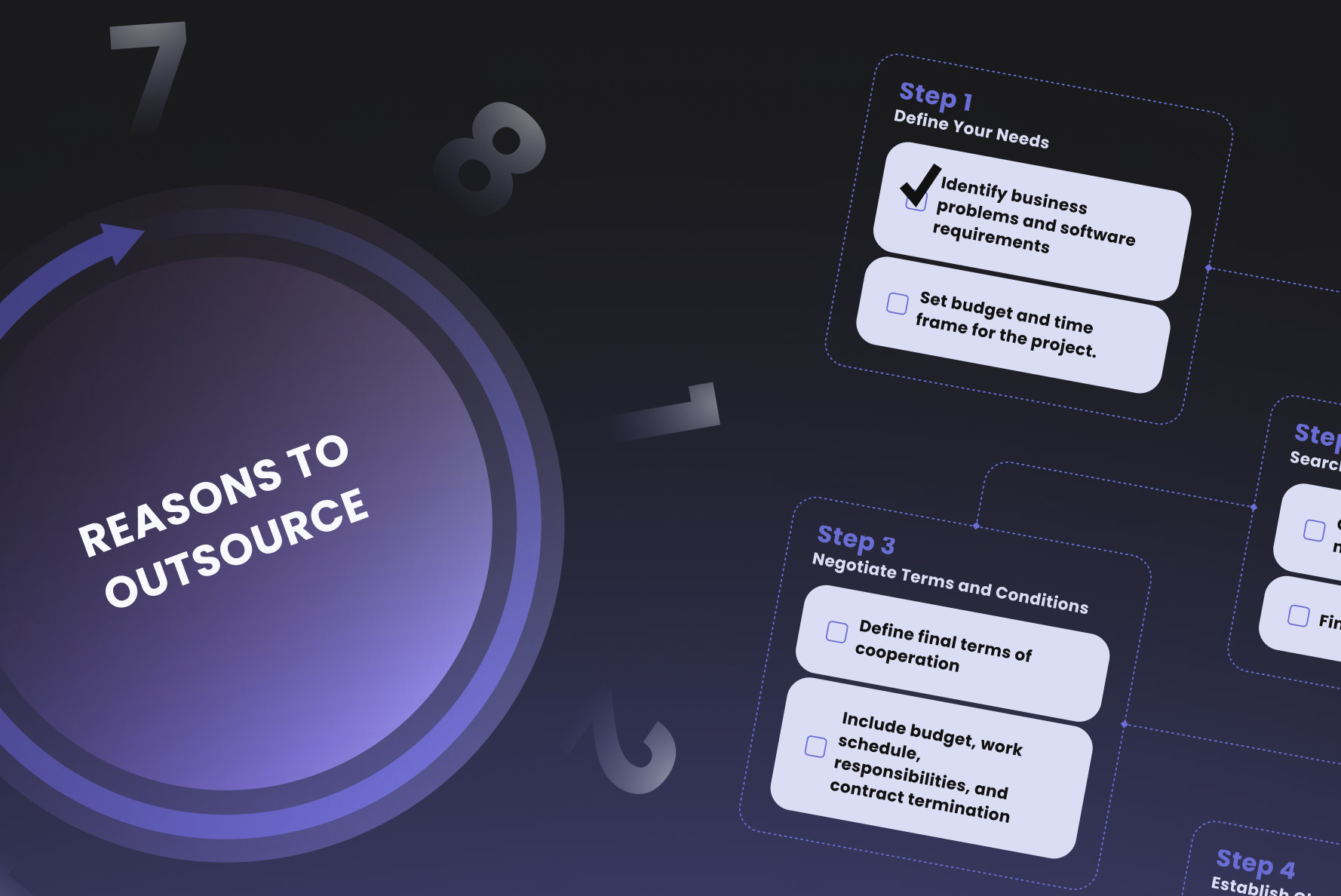More and more companies opt for software development outsourcing as developer rates grow, the tech industry becomes more competitive, and projects get more ambitious. However, it’s a flexible process with many possible pros and cons. To help you figure out when to choose outsourcing and how to do it right, we present Uvik’s complete guide.
Uvik has spent over eight years as an outsourcing vendor, augmenting companies’ staff. It’s an essential service as many companies can’t practically hire an entire department of developers for just one project. Outsourcing helps keep costs manageable while still running ambitious projects and getting good results.
In this guide to software development outsourcing, we will talk about the advantages and potential risks of outsourcing. Then, we’ll explain how to pick the right partner and keep the cost manageable. We’ll round things out with some management tips and examples of good outsource collaborations. Without further ado, let’s get started.
In-House vs Outsourcing – Which is Better?
While in-house development has long been the standard, it still has its drawbacks. For one, you’d need to hire and keep all that staff employed. That incurs expenses for office space, onboarding, salaries, and more. Whereas outsourcing software development lets you get a team for a single project, working remotely, and not requiring any extra spending.
Moreover, in-house means your regular team will be all in on the product, taking resources away from all other processes. With outsource developers, you can commit to ongoing matters while these remote workers handle the new project for you. It’s an easy way to juggle multiple things and prioritize what matters.

Advantages and Disadvantages of Software Outsourcing
Now, we don’t want to make you think that outsourcing software development is a perfect cure-all. There are pros and cons to go through here, and we’ll list them in this section. Let’s start with the obvious – outsource models are quite flexible. Most of them are remote, but ones like nearshore software development help you have an external team still in your timezone.
This flexibility guarantees you can keep steady communication with a team by choosing based on their location and professional qualities. Outsourcing development makes it easy to cherry-pick the best team members, guaranteeing good results. However, the other side is that outsourcing always implies great trust in your partner.
It’s much harder to be hands-on with a project when it’s done by an outsource team than it is with an in-house one. Thus, some managers face initial struggles trying to guide development according to their usual procedures.
For example, two of Uvik’s engineers signed on to augment work on a project that was part of the client’s overall infrastructure. The first collaboration stages proved to be tough. The client’s manager wasn’t accounting for the fact that these engineers had to be brought up to speed about the products.
Thankfully, the solution was a simple one. A quick consultation on the context of the project helped integrate the engineers with the in-house team. Despite the con of initial “acclimation”, outsourcing software development is a powerful tool and will only get better with time. As you settle into a workflow and get used to your new partners, your collaboration will become much more structured and smooth.
Challenges and Risks in Development Outsourcing

So, what risks are present when you choose outsourcing? Here’s a list:
- Dishonest partners;
- Hidden fees;
- Lack of data security;
- Lack of confidentiality;
- Low overall quality.
The brunt of the risks associated with outsourcing can be avoided through careful preparation. For example, one common issue is “hidden fees.” That is, a vendor provides a price breakdown that you find agreeable, only to add some other expenses onto it later. This is usually a result of unforeseen issues, overtime work or forced reassignments of team members.
Another risk lies in data security and keeping project information confidential. You can obviously expect experienced teams to guarantee those like Uvik does. However, the market is saturated with vendors, and it’s up to you to filter out the low-quality services. In fact, these are both pros and cons of outsourcing software development – a vast number of vendors to choose from.
There is also the matter of establishing quality benchmarks. Your team of choice should provide a good product, and you should have acceptance criteria in the contract. However, the easiest way to make sure everyone is happy is clear communication.
Selecting the Right Outsourcing Partner

So, you decide to hire software developers, but how to find the right ones? Well, here are the main criteria to look out for:
- Experience with similar projects;
- Broad tech stack;
- Delivery capabilities;
- Cultural fit.
Experience with Similar Projects
The first one is pretty self-explanatory. You want a company that isn’t just a veteran on the market but one that’s worked with projects similar to yours. That way, quality is guaranteed, and they might be able to offer some know-how that competitors couldn’t. Find someone who can make you outsourcing software development worth it.
Broad Tech Stack
Next is having the kind of tech stack that can create options for your project. The team must be well-rounded with professionals that cover various aspects of the product. For example, Uvik provides frontend and backend developers, as well as DevOps staff. This way our expertise is both broad and deep, guaranteeing cross-functionality.
Delivery Capabilities
Similarly, delivery capabilities are essential. Projects with a wider scope must have a sufficiently large team assigned to them. After all, no matter how hard 10 people may try, they can’t cover the working hours of a 20-person team, at least not in the same timeframe.
Cultural Fit
Lastly, make sure the company you delegate to is a right cultural fit. Both in terms of business culture and personal values. Their reputation will be tied to yours once you collaborate, so discuss how this team structures their work, hour by hour, and what their contingency plans are. You want to be outsourcing your software development to well-prepared professionals.
Cost of Development Outsourcing
Let’s talk about what sets the expenses of outsourcing, from the employee hourly rate to the country your vendor resides in. So, the following things matter:
- Team’s experience;
- Vendor location;
- Project complexity;
- Project length;
- Number of developers.
While outsourcing was once seen as a cheap replacement for an in-house staff, nowadays, it’s priced more fairly. The real advantage lies in your access to the global talent pool, so the cost of outsourcing software development won’t be shockingly low. Prioritize teams that offer the best portfolios and quality within your budget; chasing deals simply isn’t relevant in this niche.
As for project length, consider that any custom software development will require post-launch support. It’s better to stick to one vendor throughout, as having another team come on and learn the ropes will just result in you spending more money. Similarly, trying to shrink the team you hire could help save early but then any challenges or delays will be harder to manage.
Our advice when it comes to outsourcing of software development would always be to prioritize quality and certainty over small budget considerations. A good team pays for itself. If you’d like to learn more about how the cost of development is formed, we have an in-depth guide to that.

Best Practices for Successful Development Outsourcing
So, once you’ve picked a team, how do you manage them properly to take full advantage of the benefits of outsourcing software development? Here are a few tips.
Establish Expectations
First and foremost, set clear expectations for the project and check-in points to track progress properly. Establish how you want to communicate with the team and the desired frequency of reports. This helps you, as the client get exactly what you want, while the employees will understand what’s expected of them.
Connect with the Employees
Second, take the time to know the team you’re hiring. You know their technology competency, but, for a long-term collaboration, you should know them as people and workers. Find out their strong sides and use that knowledge to make the project go smoothly. You know how to outsource software development, but these people will know how to get you the best result.
Set Midway Goals
Lastly, don’t treat any time on the project as less important than the rest. While you have the end-goal in mind, it’s crucial to continuously monitor the progress and assure everything’s good. You as a manager have the most power in this situation and can really help the project succeed.
Successful Outsourcing Case Studies
Now that you know everything about the software development outsourcing process, let’s look at some examples of successful outsource collaborations.
GitHub
One of the most interesting ones is the creation of GitHub. Known to every developer worldwide, this massive platform only exists now, thanks to its current CIO being hired as an outsource consultant after a conference.
Slack
Similarly, everyone knows what Slack is and what it looks like. That iconic logo and design are recognized worldwide, all thanks to an outsourced design. MetaLab designed Slack to stand out among the all-business fleet of corporate solutions, making it playful and colorful. Without that design, who knows if Slack would be even half as popular today?
Alibaba
Last but certainly not least, you’ve likely heard of Alibaba, one of the world’s biggest digital marketplaces. Back in the days of its creation, China didn’t have that many specialists that could make a platform to rival eBay, a crucial requirement. Thus, it turned to outsourcing in software development, hiring a US vendor to build the site and its inner workings.
As you can see from these three examples, sometimes a bit of delegated work is all you need to kickstart your product to excellence.
Future Trends in Software Development Outsourcing
While there are a lot of moving parts in the outsource industry, some trends come to mind right away:
- IAAS and PAAS;
- AI augmentation;
- Task automation.
Two of these are Infrastructure-as-a-Service and Platform-as-a-Service. Under the first one, companies will outsource their bandwidth and storage space to companies that need them for daily operations. The second is similar – companies using premade platforms for their solutions.
As with the rest of the tech world, AI also makes waves in the industry. For one, there’s a huge demand for team augmentation with AI engineers. Moreover, certain companies are already offering to outsource their AI models. There’s also the chance that trained AI could disrupt augmentation models altogether. Using automation instead of real staff is a future possibility.
These are the main software development outsourcing trends for now, although the industry is always changing, just like any tech sector. If you want to learn more about how this sector is evolving and what these shifts will mean for you, you can get in touch for a quick consultation.
Our Team as Your Outsource Development Partner
It’s a common point in discussions of outsourcing IT development: the partner you choose determines how well it will go. As you may guess, Uvik is offering its services and we’re happy to explain why we’re the best choice. Throughout the years, our team has worked to successfully supplement companies’ staff, providing them the benefits of staff augmentation.
Staff Augmentation for a Marketplace
For example, Uvik helped a marketplace by boosting their database scraping efforts. With just two extra people, we made their data collection much more efficient. Thus, the company managed to stand up to heavy competition. All that thanks to outsourcing in software development, as their in-house staff wasn’t sufficient for the task.
Delivering Quality for a Mobile Messaging Platform
Similarly, we helped a mobile messaging platform speed up their releases. Uvik’s professional work helped increase productivity and let the company do their community-driven work better. The project is ongoing, with a focus on making the platform even more secure, as Uvik is especially committed to reinforcing their clients’ software.
Final Thoughts
We have demonstrated that software development outsourcing is a powerful and beneficial tool, especially when you have a reliable vendor to mitigate the regular risks. While there is a place and time for in-house development, working with an outsource team frees up your employees. Plus, it’s a good way to deliver important projects on time and within the preset budget.
The best part, though, is that you don’t need to go far to start your outsourcing journey. Just rely on Uvik – a time-tested company that’s been helping create custom solutions for 8+ years. If you want to get the best parts of outsourcing without worries or doubts, you know where to turn. Contact us now to get started.












